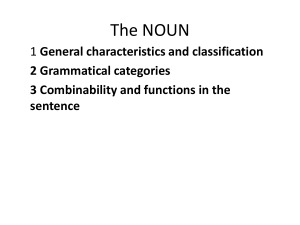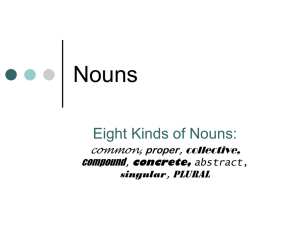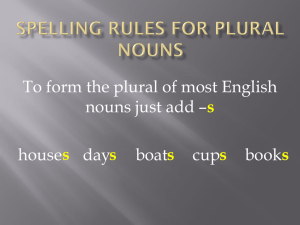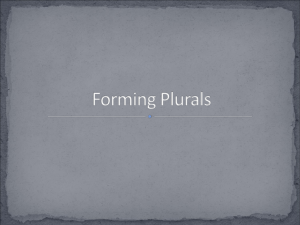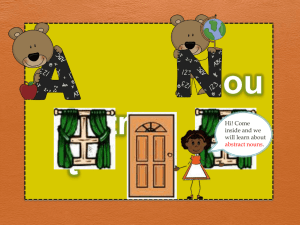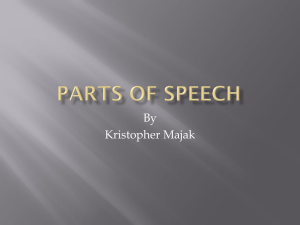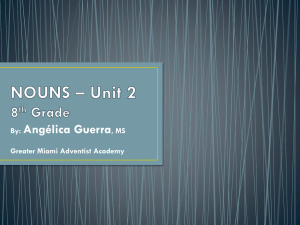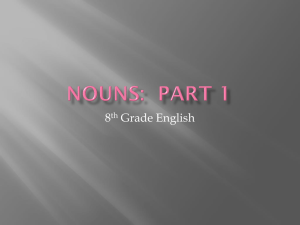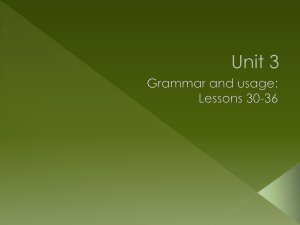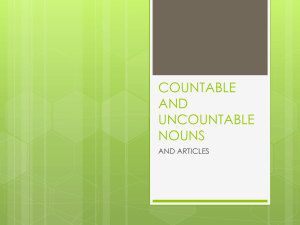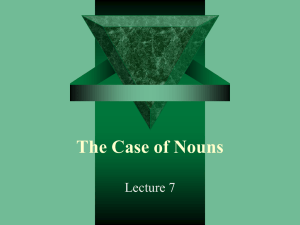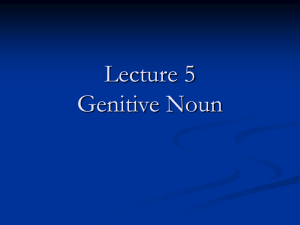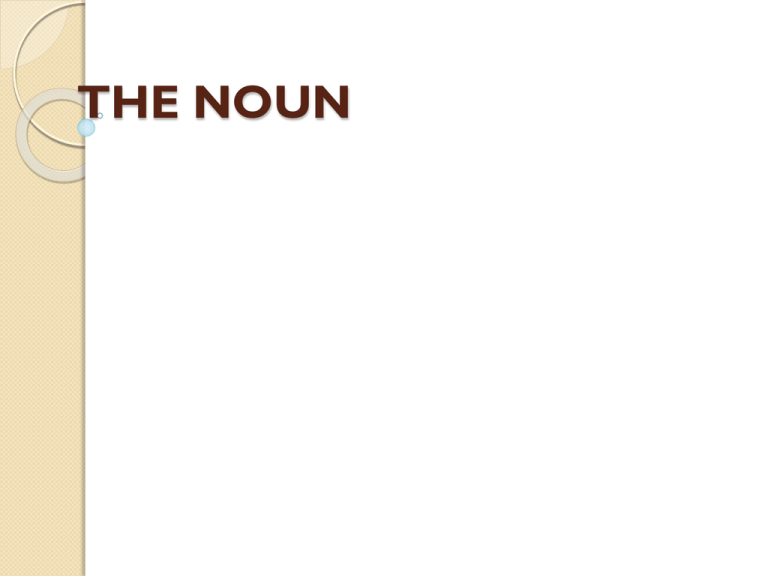
THE NOUN
The Noun in Modern English has only two
grammatical categories, number and case. The existence of
case appears to be doubtful.
The
noun
grammatical gender.
has
not
got
the
category
of
NUMBER
Modern
English,
as
most
other
languages,
distinguishes between two numbers, singular and plural.
The opposition is "one - more than one": table- tables,
pupil- pupils, dog- dogs, etc.
The category of number in English nouns gives rise
to several problems.
Pluralia Tantum and Singularia Tantum
There are two types of nouns differing from all
others in the way of number. The nouns which have only a
plural and no singular are usually termed pluralia tantum
(which is the Latin for plural only), and those which have
only a singular and no plural are termed singularia tantum
(the Latin for singular only).
Among the Pluralia Tantum are the nouns trousers,
scissors, tongs, pincers, breeches; environs, outskirts,
dregs.
On the one hand, among the Pluralia Tantum there
are nouns which denote material objects consisting of two
halves (trousers, scissors, etc.); on the other, there are those
which denote a more or less indefinite plurality.
e. g. environs=areas surrounding some place on all sides;
dregs =various small things remaining at the bottom of a
vessel after the liquid has been poured out of it, etc.
In some cases English and Russian Pluralia Tantum
nouns correspond to each other (trousers - брюки, scissors
- ножницы, environs - окрестности, etc.), while in others
they do not (деньги – money, etc.).
The direct opposite of Pluralia Tantum is the
Singularia Tantum, i.e. the nouns which have no plural
form. Among these we must first note some nouns
denoting material substance, such as milk, butter,
quicksilver, etc., and also names of abstract notions, such
as peace, usefulness, incongruity, etc.
Some nouns denoting substance, or material, may
have a plural form, if they are used to denote either an
object made of the material or a special kind of substance,
or an object exhibiting the quality denoted by the noun.
Thus, the noun wine, milk, denotes a certain substance, but
it has a plural form wines used to denote several special
kinds of wine.
The noun iron (or quicksilver), denotes a metal, but
it may be used in the plural if it denotes several objects
made of that metal (irons - утюги).
The noun beauty (ugliness) denotes a certain quality
presented in an object, but it may be used in the plural to
denote objects exhibiting that quality, the beauties of
nature; His daughters were all beauties.
This is called lexicalization of the plural number.
Here are some other examples:
authority
cloth
colour
custom
damage
development
disturbance
direction
draught
honour
humanity
picture
authorities
clothes
colours
customs
damages
developments
disturbances
directions
draughts
honours
humanities
the pictures
duty
talk
power
work
glass
duties
talks
powers
works
glasses
Collective Nouns and Nouns of Multitude
Certain nouns denoting groups of human beings (family,
government, party, clergy, etc.) and also of animals (cattle, poultry, etc.)
can be used in two different ways: either they are taken to denote the
group as a whole, and in that case they are treated as singulars, and
usually termed "collective nouns"; or else they are taken to denote the
group as consisting of a certain number of individual human beings or
animals, and in that case they are usually termed "nouns of multitude".
My family is small.
My family are good speakers.
The cattle were grazing in the field.
CASE
The problem of case in Modern English nouns is
one of the most vexed problems in English grammar. The
views on the subject differ widely. The most usual view is
that English nouns have two cases: a common case (father)
and a genitive (or possessive) case (father's). Side by side
with this view there are a number of other views, which can
be roughly classified into two main groups:
(1) the number of cases in English is more than two,
(2) there are no cases at all in English nouns….
Case expresses relations between the thing denoted
by the noun and other things, properties, actions, and
manifested by some formal sign in the noun itself. It is
obvious that the minimum number of cases in a given
language system is two, since the existence of two
correlated elements at least is needed to establish a
category.
From this angle, no cases expressed by non-morphological
means can be recognised. It will be therefore impossible to accept the
theories that case may also be expressed by prepositions (i.e. by the
phrase "preposition + noun") or by word order. Such views have indeed
been propounded by some scholars, mainly Germans.
Thus, it is the view of Max Deutschbein that Modern English
nouns have four cases, viz. nominative, genitive, dative and accusative,
of which the genitive can be expressed by the -'s inflection and by the
preposition of, the dative by the preposition to and also by word order,
and the accusative is distinguished from the dative by word order alone.
If prepositions, or word order, or any non-
morphological means of expressing case are admitted, the
number of cases is bound to grow indefinitely. Thus, if we
admit that of the pen is a genitive case, and to the pen a
dative case, there would seem no reason to deny that with
the pen is an instrumental case, in the pen a locative case,
etc.
Thus the number of cases in Modern English nouns
would become indefinitely large. This indeed is the
conclusion Academician I.I.Meshchaninov arrived at.
Thus, the number of cases in Modern English nouns cannot be
more than two (father and father's). The latter form, father's, might be
allowed to retail its traditional name of genitive case, while the former
(father) maybe termed common case, first used by Henry Sweet. Of
course it must be borne in mind that the possibility of forming the
genitive, acc. to Prof. Ilyish, is mainly limited to a certain class of
English nouns, viz. those which denote living beings (my father's room,
George's sister, the dog's head) and units of time (a week's absence,
this year's elections), and also some substantivized adverbs (to-day’s
newspaper, yesterday's news, etc.).
The following views have been put forward on -’s as a case
inflection in nouns:
(1)
when the -'s belongs to a noun it is still the genitive ending,
and when it belongs to a phrase (nobody else’s business, Smith and
Brown’s office) (including the phrase "noun + attributive clause") it tends
to become a syntactical element, viz, a postposition,
Ex: The blonde I had been dancing with’s name was Bernice
something – Crabs or Krebs. /Salinger/;
(2)
since the -'s can belong to a phrase it is no longer a case
inflection even when it belongs to a single noun;
(3)
the -'s when belonging to a noun, no longer expresses a case,
but a new grammatical category; viz. the category of "possession".
Prof. Ilyish concludes that the original case system
in the English nouns is at present extinct, and the only case
ending to survive in the modern language has developed
into an element of a different character - possibly a particle
denoting possession….
The point of view we’ll stick to is that there are 2
cases in English nouns.
GENDER
Gender is a less important category in English than
in any other languages. It is closely tied to the sex of the
referent and is chiefly reflected in co-occurrence patterns
with
respect
to
singular
personal
pronouns
corresponding possessive and reflexive forms.
and
Although there is nothing in the grammatical form
of a noun which reveals its gender, there are lexical means
of making gender explicit, and reference with a third
person singular pronoun may make it apparent.
However, gender is not a simple reflection of
reality; rather it is to some extent a matter of convention
and speaker’s choice, and special strategies may be used to
avoid gender-specific reference at all.
The following lexical means make gender explicit.
There are lexical pairs with male-female denotation, chiefly
among words for family relationships (father-mother, uncle-aunt, etc),
social roles (king-queen, lord-lady, etc.), and animals (bull-cow, cockhen, etc).
The masculine-feminine distinction may also be made explicit
by formal markers:
by separate words, that is lexically: male nurse, a female officer, an
Englishman, a policewoman,
by special morphemes, that is morphologically: actress, tigress,
usherette, proprietrix, heroine)
First, and most importantly, this skewed distribution
reflects societal differences in the typical roles of men and
women, where men still hold more positions of power and
authority than women. Related to this difference, there is
some evidence that speakers and writers simply make
reference to men more often than women.
Second, the differences in language use reflect a
linguistic bias, because masculine terms can often be used as
duals, to refer to both men and women, but not vice versa.
The most common nouns ending in –ess or –er/or
are princess – prince, actress-actor, mistress-mister,
duchess-duke, waitress-waiter, countess-count, goddessgod, hostess-host, stewardess-steward. It is worth noting
that the uniquely feminine terms tend to refer to social
roles of smaller status than most masculine terms.
Thus, 5 of the 7 feminine words with no masculine equivalent
have meanings that are derogatory or denote menial social roles:
beggarwoman, charwoman, ghostwoman, slavewoman, sweeperwoman.
In addition, many of the terms in feminine / masculine word pairs are not
in fact equivalent. Instead, the feminine term often denotes a lesser social
role or something with a negative overtone compared with the masculine
term:
spinster
bachelor
governess
governor
mayoress (the wife of a mayor)
mayor
mistress
master
tigress
tiger
witch
wizard
To be continued

